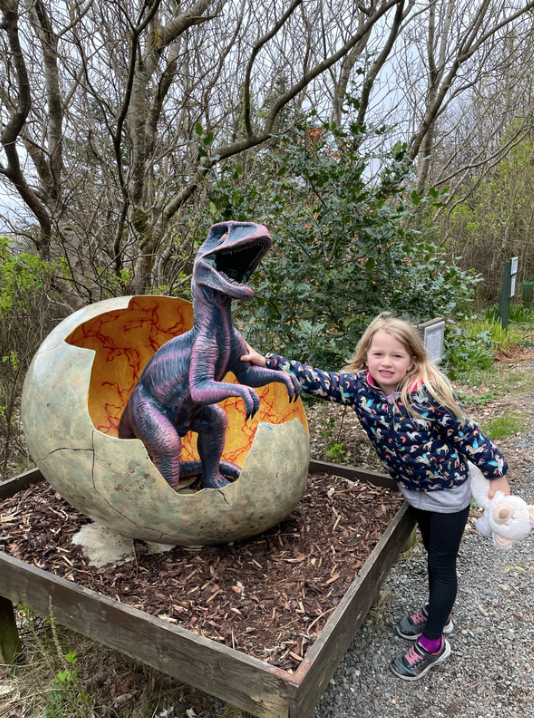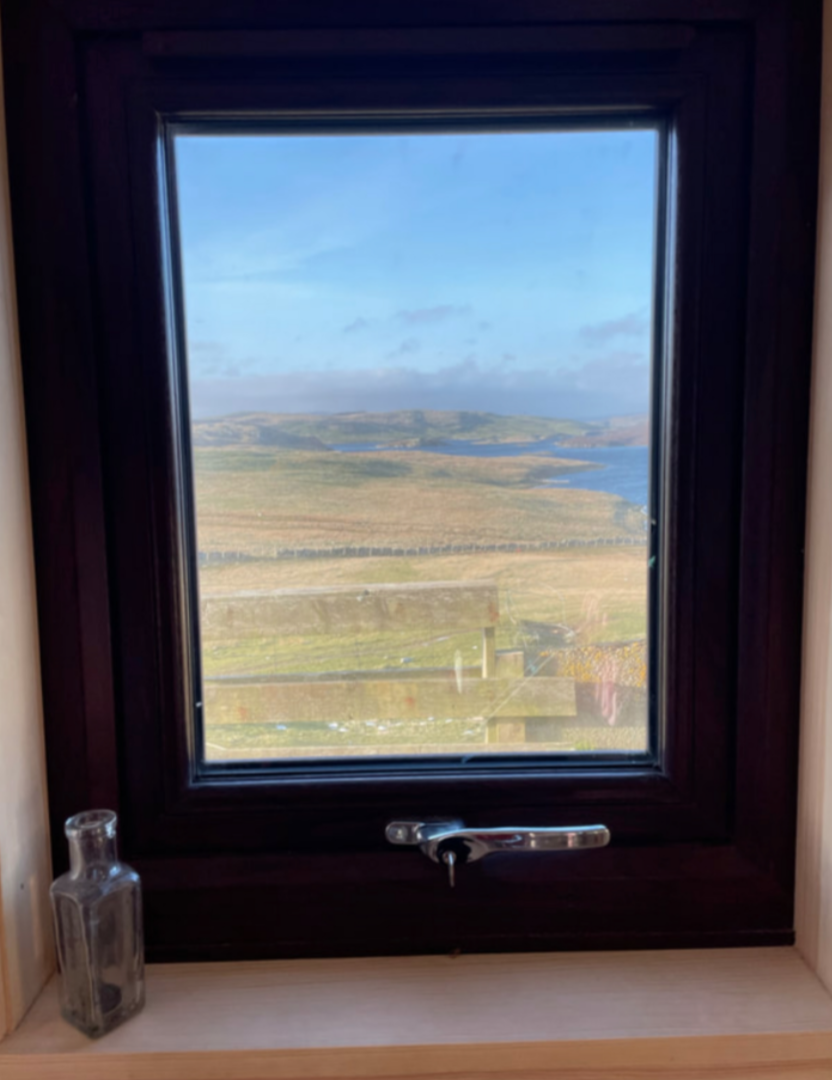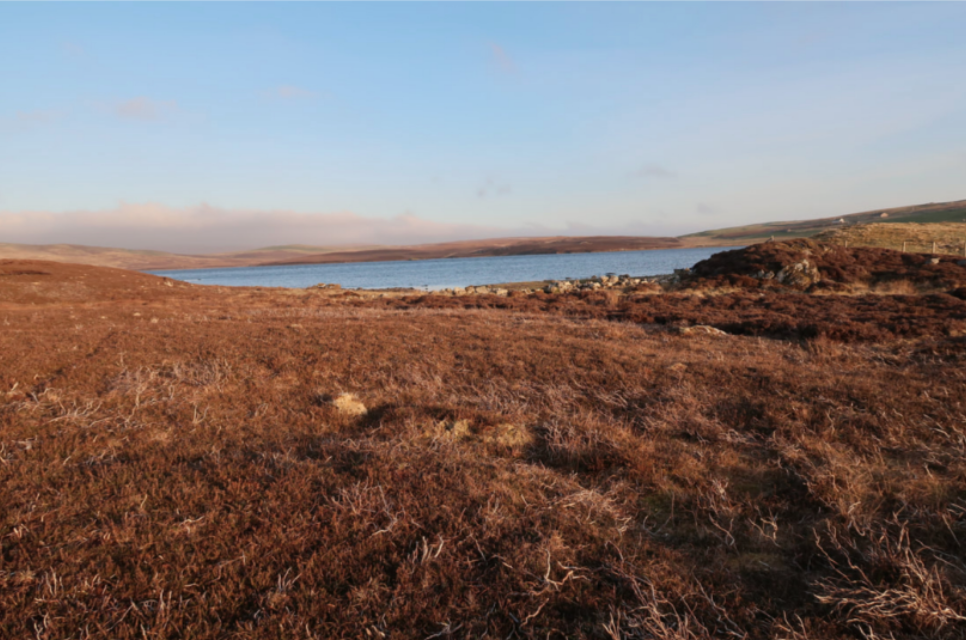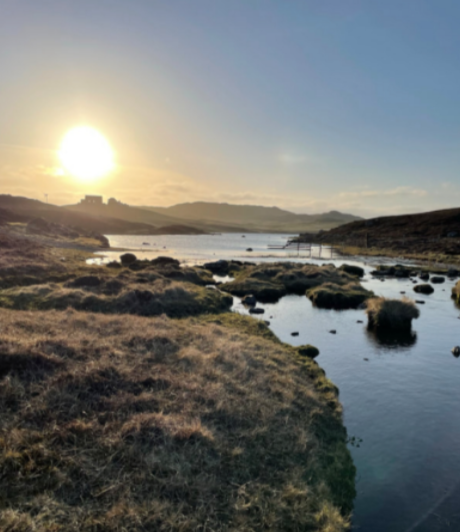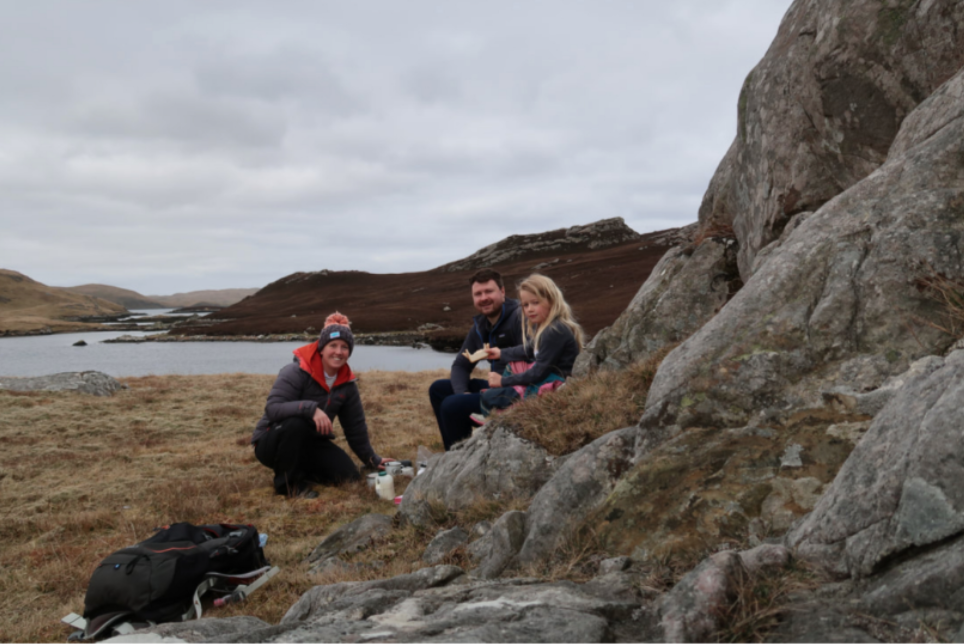The Old Manse Holiday Home, Clousta: A review of our stay and your own West Mainland itinerary
The Old Manse Holiday home is the white house in the centre, beside the former Clousta church.
“The winding voes and lakes of Clousetter, are wildly disordered by the irregular encroachments of the hills among which they run. Nature, from mere rocks and water, without the assistance of a single tree, has presented ceaseless varieties of interesting scenery.”
~ Samuel Hibbert (1818)
Clousta is an ‘old place’ – it has that sense, as if you’ve suddenly stumbled off the map. It’s a beautiful corner of Shetland’s West Mainland, inconspicuously tucked away somewhere between Eid (Aith) and West Burrafirth.
Noonsbrough, Clousta
Clousta’s rural feel reminds me of my childhood days growing up in Waas (Walls), where days were marked by the moving of the sun across the sky and seasons were marked by nature; lambs, tadpoles and ploughing in spring; power cuts, UHT milk and whistling winds in winter. Summer brought those halcyon days spent outside with scraped knees and guttery hands and times when it felt as though the sun shone for the entire six weeks of school holidays.
I’m always drawn to the West Mainland, perhaps because I spent several years growing up here, and it brings back happy memories, but more likely because it’s stunningly beautiful and there are plenty of quiet corners that are less explored.
Locally we say that “west is best”, and this is because generally, the sun shines more on the West Mainland. As the east side and South Mainland are shrouded in mist and summer fog, the West Mainland will be basking under sunshine and blue skies.
Celebrating the sun at Stanydale in Shetland's West Mainland
I’ve written about the magic of the West Mainland before, and you can read about a moving experience I had at the Stanydale Temple to mark the spring equinox.
Home for the weekend is the stunning Old Manse Holiday Home in Clousta
Stanydale Temple is not far from where we based ourselves for our weekend in Clousta. Graham and Ruth Willmore have recently added their home to Airbnb. This house is the only place that Graham – until recently – has ever lived, and the house feels very much loved and has been renovated to a high standard, showing love and respect for the building’s past.
As the name suggests, the house is an old Church of Scotland Manse or the place where the minister would have lived. Unsurprisingly, the building is right next door to the former church, or ‘kirk’ as they are known in Scotland.
Historic photo of the Manse and kirk that's on display in the holiday home - a nice reminder of the building's past
This is a fantastic base for anyone who wants to walk and hike in the area. For those interested in trouting, Neolithic [stone age] archaeology and the general solitude of the hills, this area is ideal to act as your springboard to discovering the West Mainland.
In this blog, I’ll speak about what we did to fill our weekend and give some other suggestions for walks and things to see and do if you are staying for longer.
Friday
Clousta is a 20-mile drive from Lerwick and will take about half an hour. To get to The Old Manse:
Follow the A970 and A971 for 18 miles before joining the B9071 after Bixter towards Aith.
At the top of the hill, take a right turn towards Twatt and Clousta.
Follow this road for about three miles.
Turn right at the ‘red phone box’, and you’ll find the Old Manse at the end of the road.
The 'iconic' British phone box at Clousta, around the corner from The Old Manse Holiday Home
We left Lerwick at tea time and arrived with the evening sun streaming in the lounge windows and the gentle sound of the skylark telling us that we were now out of the town and safely ensconced in the country.
The house is generously sized and instantly welcoming, with a bright sign to greet guests entering the front door. Inside, there are four good-sized bedrooms (two doubles, one twin and a single room), a large kitchen-diner, two reception rooms with a wood or peat burning stove, and a modern, clean bathroom with a bath and separate shower. A small utility room off the kitchen enjoys the most breathtaking views across the Clousta Loch towards Vementry. I could have done laundry here all day long!
Noonsbrough, the remains of an Iron Age broch
After dinner, we had a walk to Noonsbrough, a few miles from the Old Manse, where, as the name suggests, we found the ruined remains of a 2,000-year-old Iron Age broch. There are about 120 broch sites in Shetland, and most stand in ruin. Travelling through the islands, you become better at spotting these in the landscape or through placenames, such as here at NoonsBROUGH.
Samuel Hibbert visited Noonsbrough during his 1818 tour of Shetland, and he described what he found: “Nunsburgh, a bold eminence, rises to the west of Clousetter, the fortalice which gives rise to its name, being almost wholly rased.”
Like most Iron Age brochs in Shetland, Noonsbrough stands in ruin, collapsed in on itself, with only a metre or so of the original wall still standing. Although, the inner and outer walls can be seen when viewed from the top. Surrounding the outer broch wall, a later boat ‘noost’ structure has been added to the broch, creating a sheltered space for hauling up boats in the winter to protect from the worst of the weather.
Beautiful evening sunshine looking across to Clousta and The Old Manse Holiday Home
In the evening, it was time to open a bottle of wine and relax. The Old Manse has a large tv with Freesat and Netflix available and ambient ceiling lights that you can set to any colour. It’s the perfect way to unwind – that and a bath – after a walk through the surrounding hills.
Saturday
I woke up to the sound of a blackbird happily singing, and I felt rested. The sun was shining, and it was lovely to open the blinds and look out across the open countryside, still parched after the long winter but with traces of green starting to show through the muted yellow and brown of the post-winter landscape. Our visit coincided with the lambing season – a busy period for the many crofters who keep sheep on the islands. I could see the crofter on the other side of the valley out working his sheep in the early morning sun, a reassuring reminder that spring was coming around once more despite all the chaos in the world.
Beautiful views in the morning from The Old Manse Holiday Home - views like this should be bottled!
It was just myself and Lena for the day – Aaron was working, and Hansi was staying with friends at a local outdoor centre – so we had a day planned, just the girls, and had decided to spend it in the neighbouring village of Aith, known locally as Eid.
Aith Marina
Eid is just a few miles from Clousta and is the largest village in the West Mainland. The village has a great community feel and is served well by several local amenities, including a shop, marina, leisure centre, school and public hall.
Including our trip to the Cake Fridge, playpark and swimming pool, Lena and I spent the morning at Michaelswood and the afternoon up the Burn of Lunklet.
Michaelswood
The gardens at Michaelswood are one of the first places you come to as you reach the village, and certainly, the woodland area is one of the first things you will spot. In an almost treeless landscape, any collection of trees and shrubs stands out.
Michaelswood is a community garden established in memory of Michael Ferrie, a young musician from Aith who died in 1996. The gardens, established by his family, have continued to grow, develop and bed into the landscape over the years, providing a haven for both wildlife and visitors to the area.
The wooded area features a trail through the trees with lots of interesting spots along the route for children to discover and explore, including picnic areas, a bird hide, toys and a collection of show-stopping, life-size (ish) dinosaurs. There are also swings and a children’s play area complete with picnic benches for weary parents to sit and relax. Children love to explore the trail, discovering all the dinosaurs that punctuate the path with their incredible presence. For adults, motivational quotes framed on wooden posts line the route and are sure to put a smile on your face.
If you’re looking to warm up or have a picnic after exploring the woodland, a polycrub (reinforced polytunnel) houses picnic benches and soaks in the warmth from the sun. Visitors are free to use this space at their leisure and, in the summer, it’s a real suntrap!
Admission to Michaelswood is free, and there’s a donations box at the entrance for guests to leave a donation – small or large – to help them develop and grow the gardens.
(Please note that the nearest public toilets are at the Aith Marina, a short distance away).
Planting for the future at Michaelswood, Aith
Burn of Lunklet, Aith
The Burn of Lunklet
Shetland is not known for sprawling rivers that weave their way through open countryside. The hills are instead punctuated by small streams known as burns. The Burn of Lunklet is one of these and probably one of the more extensive burns found in the islands - this was our next stop after exploring Michaelswood.
You’ll find the car parking area for the Lunklet walk just a few miles east of Aith towards East Burrafirth. Be sure to stop for a picnic at the Original Cake Fridge along the way. A ‘brown tourist sign’ marks the start of the short walk up the burn.
Burn of Lunklet walk, Aith
The walk is short, taking about 10-15 minutes each way along a picturesque gravel path. Despite the trail, this route is not suitable for wheelchairs.
The impressive waterfall at Ramnahol is about a quarter of a mile upstream from where the walk begins and plunges into a deep pool before making its way downstream toward the sea. This is a beautiful, peaceful spot to have a picnic. One of the best things about this walk – and many in the surrounding area – is that you don’t have to walk very far through the hill to reach places that are out of view of all human habitation, meaning that you are alone with just the call of the birds and the gentle motion of water.
Other things to do in the area:
Aith is a fantastic place to spend time, and there’s plenty to do, including:
Michaelswood
Burn of Lunklet
The Original Cake Fridge at East Burrafirth
A walk around the pier and Marina – look out for the distinctive orange and blue RNLI Lifeboat, based in Eid to protect the waters around the west coast of Shetland
Aith Charity Shop (open Thursday 7 pm - 9 pm and Sunday 2 pm - 4 pm)
Playpark (beside the housing scheme)
Eid Community coop is a fantastic shop
Drive through the ‘Alps’ – the road linking Aith and Voe, and known locally as the Alps because of its stunning views over the hills of the westside
West Mainland Leisure Centre – swimming pool, sauna, steam room, badminton courts, gym and climbing wall
After our day trip to Aith, it was back to sunny Clousta, where we prepared tea before heading out into the hills once again. The kitchen is well stocked with pots, pans and kitchen accessories. The cupboards also contain basic store cupboard ingredients such as salt, pepper, stock cubes, sauces, tea and coffee.
My favourite view in the house, out the utility room window, looking across the Loch of Clousta
You can read more about things to do in Aith here.
The Old Mill Walk
After dinner, we decided to do one of the walks in the local area to an old watermill. This walk isn’t detailed anywhere online or in any walking books – the mill structure itself isn’t even on the OS map, but it’s a fab walk and easy to find from The Old Manse.
The mill is a traditional click mill of Scandinavian design and origin, typically found and used in Shetland from Norse times until the mid 20th century. These small mills were used for grinding grain and contained two horizontal millstones that were turned by the force of water passing through the paddle, or tirl, beneath the mill house, causing the stones to turn.
These small mills were common throughout Shetland and are often associated with lots of folklore, particularly the njuggle, a mythical creature from Shetland’s past. A njuggle is a mythical horse-like creature, similar to the Scottish kelpie, who lures unsuspecting people onto their winged-backs before careering off, carrying them to a watery grave. Njuggles are almost always associated with water – burns and lochs or damp areas such as meadows and marshes. Njuggles were the most dangerous to milling. They would get into the mill’s underhouse and stop the tirl (the paddle mechanism that drives the mill). The only way to get rid of the njuggle was to throw down a burning peat, where the njuggle would then disappear with a roar of thunder, a blinding flash and a blue flame.
Loch of Vaara, Clousta in the evening sunshine
Listen to this podcast about Shetland folklore -
For the walk:
From the Old Manse, follow the road at the back of the kirk down to Clousta Loch.
Where the burn passes over the road, take the burn south towards the Loch of Vaara.
Follow the burn south until you reach the roofless structure of the mill.
The mill sits about halfway between the Loch of Clousta and the Loch of Vaara.
From the mill, continue following the sluice channels of the former mill or the burn to the Loch of Vaara, where the original mill dam is located.
Total distance: 1.2 miles (we took an hour to explore the area, spending a little time repairing some of the sluice channel walls).
A spot of cultural restoration work on the mill's sluice channel
When I was later talking about the area with a local from Clousta, she told me that the ‘pointed’ hill above the mill – marked on the OS map as Geurawall – has a trowie story associated with it. Trows are another mythical creature from our folklore, and the story goes that a fiddler was making his way between Aithness and Clousta to play at a wedding when he happened on a trowie wedding. He listened for what turned out to be a long time, meaning he missed his marriage celebration. All was not lost, and the bride and groom forgave him for his no-show because he learned some trowie tunes – those distinctive Shetland reels that are unlike anything else.
An interpretation panel at Michaelswood tells the whole story of da peerie fok o’ Gurwil.
Gurwil's Hill is the pointy, cone-shaped mound on the hill
read my blog about trows, here
Trouting/fishing
If you’re into fly fishing, this area is rich in trouts, and the numerous lochs are well stocked. The OS map displays a fish symbol on several of the lochs surrounding The Old Manse, including the Loch of Clousta, which is on the doorstep, and the Loch of Aithsness and Clings Water, all within stomping distance.
My attempt at fly fishing in the West Mainland a few years ago
Visitors can buy fishing permits from the Shetland Angling Association. The Association operate a straightforward permit system, with a single price for visitors or locals. The pass costs £30 and entitles the angler to fish throughout the season. Junior anglers (under 16) are free.
We released this small fish back to the loch
A walk to the Brigs
Sunday
We woke to another dry day, with the stiff north wind still ensuring that our jackets were zipped up to our chins with hoods tightly pulled into our faces as we set off into the hills with a warming thermos and a picnic – and one somewhat reluctant five year old!
Today we were doing the Brigs walk from the Old Manse. This is a walk that I’ve done from Vementry and blogged about in the past, but I’d never walked in from Clousta. I also created a video tour for my patrons, and, as you’re good enough to be reading this blog, I’ll share the private link with you below, and you too can access that exclusive video, generally only available to my Patrons on Patreon.
If you enjoyed the tour and would like to access more like it, you can sign up to support me on Patreon below.
Da Brigs is an old stone causeway that crosses the sea halfway between Vementry and Clousta. You may be fooled into thinking that this is a long walk – indeed, driving from Clousta to Vementry would probably take longer than the walk. Driving between these two points takes 20 minutes over six miles.
This was the route that school children took to get to school in Clousta from Vementry and the postman also used it to deliver the mail on foot between Vementry and Clousta. Da Brigs is a stunning stone causeway and dry stone wall, with a wooden gate allowing access over the causeway. The stone walls ensure that sheep remain on the right side of the water.
For this walk, we did a circular from the Old Manse:
Follow the shore north along the west side of the Loch of Clousta until you reach Da Brigs.
This is where we had a picnic.
Note – if you take two cars and leave one at Vementry, you can join the path to Vementry here, heading east.
We continued up the hill in a southerly direction, following the access route markers.
As we crested Muckle Billerin, the first house that came into view on the other side of the valley was the Old Manse.
From here, we joined a farm track, passing the ruined house of Da Taftlands that was last inhabited in the 1940s by Williamsons who came from Papa Stour. This is reputedly the last house in Mainland Shetland to have a fire in the middle of the floor.
Once back on the main road, we followed the road back to the Old Manse, stopping to look at newborn lambs and explain to Lena what the red phone box was used for – it still blows my mind that my children have no concept of phone boxes and the concept of being totally ‘out of contact’.
This walk took us two hours, and we covered 2.5 miles, stopping for a picnic along the way.
Can you spot The Old Manse coming into view as we walked back from Da Brigs?
You can read the Brigs blog , here
Other walks and places of interest in the area:
Reawick beach
Westerwick
Kergord Woods and the Bonhoga Gallery & Cafe
We had such a fantastic time in Clousta, a corner of Shetland that’s so often overlooked and bypassed. From Clousta, a whole landscape of walks, folklore and history opens out and The Old Manse is the perfect place to base yourself to explore from.
The only thing that you’ll wish for here, is more time!

















